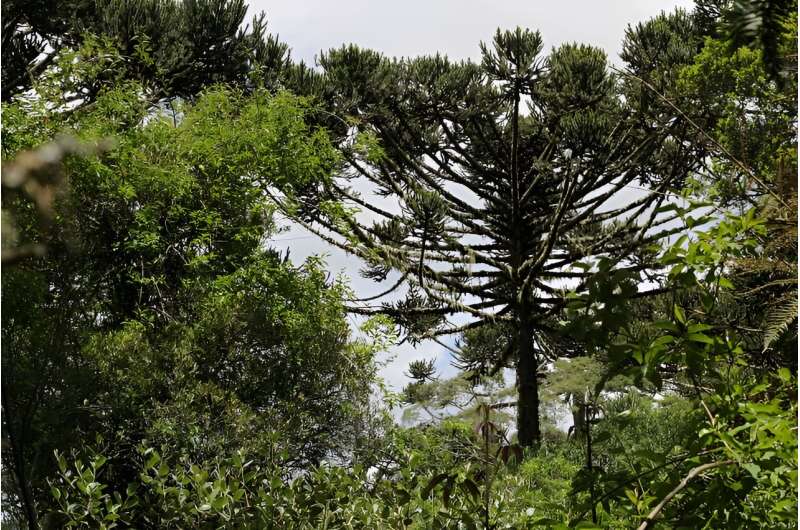A study published in the journal Science shows for the first time the degree of threat to all tree species in the biome, classifying 65% as vulnerable or endangered to some extent. According to the authors, their findings are conservative—the actual situation could be even more alarming. Credit: Anderson Kassner-Filho/Floresta SC
A study led by Brazilian researchers and reported in an article published on January 11 in the journal Science shows that 82% of the more than 2,000 species of trees found only in the Atlantic Rainforest biome are threatened with extinction to some degree, while 65% of all 4,950 tree species present in the biome, including non-endemics, are endangered.
This is the first time the degree of threat to all populations of all tree species in Brazil's Atlantic Rainforest biome has been assessed using the criteria of the International Union for Conservation of Nature (IUCN), whose Red List of Endangered Species is considered a critical indicator of the health of the world's biodiversity.
"The number [82% of endemic species threatened] came as a shock. We took forest availability into account for each species, whether or not it was healthy forest, for example. Not all species are able to survive in degraded fragments, so the actual situation may be even more alarming," said Renato Lima, corresponding author of the article.
Lima is a professor at the University of São Paulo's Luiz de Queiroz College of Agriculture (ESALQ-USP) in Piracicaba, São Paulo state, Brazil. His postdoctoral research at the Institute of Biosciences (IB-USP) included part of the study.
The authors conducted an automated conservation assessment of the 5,000-odd species using more than 800,000 herbarium records and 1.3 million tree counts from forest inventories, as well as information on species life histories, commercial uses, and long time series of habitat loss. The data for forest inventories was obtained from TreeCo, a repository administered by Lima.
Another troubling discovery was that population decline in the last three generations was less than 30% for only 7% of the endemics. Species with a decline of 30%–50% in ten years or three generations are classified as Vulnerable, IUCN's lowest level of threat. Above this level, they are Endangered or Critically Endangered.
Among the threatened species, 75% were in the Endangered category. The emblematic brazilwood, Paubrasilia echinata, was considered Critically Endangered owing to an estimated 84% decline in population size over the past three generations.
Once common species, such as Araucaria angustifolia (Paraná pine), Euterpe edulis (Jussara palm) and Ilex paraguariensis (Yerba mate), have lost at least 50% of their populations and are classified as Endangered.
Species endemic to the Atlantic Rainforest, such as Brazilian sassafras (Ocotea odorifera) and Brazilian walnut (Ocotea porosa), have lost 53%-89%, and are listed as Endangered or Critically Endangered.
First such assessment ever
IUCN categorizes animal and plant species extinction risks based on multiple criteria, divided into A, B, C and D. In this study, the researchers found that the more data they used, the more the degree of threat increased.
Simply put, population decline in the last three generations is criterion A, geographic range (the area occupied by the species) is B, and small and declining population or very small population (under 10,000 adults) are C and D.
"When we included few IUCN criteria in the assessments, which is what most researchers had done before, we obtained six times fewer threatened species. The use of criteria that took the impact of deforestation into account drastically affected our assessments of the degree of threat to Atlantic Rainforest species, which was much worse than we previously thought," Lima said.
To illustrate the difference, the researchers separated a set of species for which data was available on all four criteria and assessed the degree of threat. For all species of the subgroup, 91.4% were threatened according to criterion A. For endemic species, the proportion was 90.3%.
According to criterion B, the only one of the four used in most assessments of this kind, only 10.7% of all species and 16.6% of endemics were threatened. According to C and D, the proportions were 2.5% for all species and 3.2% for endemics.
The innovative methodology will be used from now on to estimate the degree of threat to some 12,000 plant species endemic to Brazil and not yet included in any such assessment. The research is being conducted by the Rio de Janeiro Botanical Garden's National Center for Conservation of Flora, where two of the co-authors of the article work.
The authors advocate global use of the methodology. In a simulation based on data for other tropical forests, they found that 30%–35% of the planet's tree species may be threatened by deforestation alone.
"Information of this kind is critically important to the formulation of public policies for conservation and reforestation. The most degraded areas and threatened species can be prioritized without overlooking areas where there are forests that may not be viable in the long run if nothing is done now," Lima said.
The good news is that the authors of the article rediscovered five species considered extinct in the wild. On the downside, they determined that 13 species endemic to the Atlantic Rainforest are possibly extinct.
More information: Renato A.F. De Lima et al, Comprehensive conservation assessments reveal high extinction risks across Atlantic Forest trees, Science (2024). DOI: 10.1126/science.abq5099. www.science.org/doi/10.1126/science.abq5099
Journal information: Science
Provided by FAPESP
























